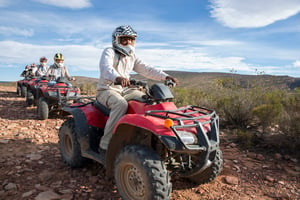 Recreational vehicles are becoming increasingly popular. With a variety of makes and models, it makes it easier to find the perfect one for you. However, it’s still important not to ignore safety considerations when operating these vehicles.
Recreational vehicles are becoming increasingly popular. With a variety of makes and models, it makes it easier to find the perfect one for you. However, it’s still important not to ignore safety considerations when operating these vehicles.
ATV stands for all-terrain vehicle; these are typically for a single rider and can be referred to as four-wheelers or quads. ATVs also use handlebars and a thumb or twist throttle to accelerate. UTV stands for utility terrain vehicle. UTVs are designed with a cabin for two or four riders and can be referred to as a side-by-sides. These vehicles have a steering wheel and foot pedals.
Now that you understand the difference between the two, it’s time to talk about safety. If you’re looking to operate one of these vehicles, a safety course is a great starting point. Some states may require this depending on your age, but it’s not a bad idea regardless. I’m going to discuss a few safety tips that are beneficial when choosing to ride a recreational vehicle.
1. Invest in appropriate safety gear.
This may include over the ankle boots, long pants, long-sleeved shirt, goggles, and one of the most important pieces of safety gear, a helmet. Be sure you know the laws in the area you’re riding; some states may require a helmet. Even if you’re using a seat belt in a UTV, a crash, collision, or rollover could still cause a head injury. You’ll want to be sure the helmet meets The U.S. Department of Transportation (DOT) and/or SNELL safety standards. Riding gloves are another great idea to improve your grip and protect your hands while riding.
2. Buy the right unit for you.
There are many different sized machines, and some are higher powered than others. Additionally, some have age requirements and a driver’s license may be required to operate. Check out the vehicle’s owner’s manual for this information to ensure you’re riding a machine meant for your size/age.
3. Fully understand the controls and parts of the ATV/UTV before you start it up.
Never assume you know how to operate a machine you aren’t familiar with. Be sure to review the owner’s manual and take time to practice in a safe, level area so you’re completely comfortable with the machine before you go riding.
4. Understand the laws and regulations.
It’s important to be sure you’re not doing anything illegal or jeopardizing long-term trail access for other riders. When you’re riding on public terrain there can be many other riders. Always be considerate of other riders; don’t stop in the middle of a trail or ride side by side as there could be oncoming traffic. Keep yourself and others safe while practicing good trail etiquette.
5. Respect the machine.
While riding, you could be on rough terrain, hills, or water, or you could be out after dark. When operating an ATV uphill while seated, you’ll want shift into a lower gear, gently throttle to maintain momentum, and slide far enough forward to position your torso over the front wheels or handlebars. When going downhill, shift your weight to the rear, use a lower gear, and maintain a slower speed while braking gradually. If you’re going to cross water at any point, you’ll want to be sure you’re familiar with the depth of the water and if the machine can handle it. In case you end up out after dark, be sure your headlights are clean and working properly before you leave for the day.
Lastly, avoid driving too fast. While it may seem fun or, you may feel the need to keep up with other riders, this can be very dangerous. At high speeds you have less control, and an obstacle can appear much quicker with less warning. Turns are also more difficult at high speeds, and you could run into ruts, potholes, etc. that could become very dangerous. Always keep a safe, comfortable, controllable speed when operating these machines.
While there are many safety tips for riding ATVs and UTVs, these are just a few ways to help stay safe, and hopefully ensure riding remains a fun sport for all. If you own a recreational vehicle, contact your independent agent to be sure you have the correct coverage on your unit(s).
Do you have any suggestions or information you’d like to share? I’d love to hear from you. Please share them in the box below.
This blog was written by Jamie Wamsley, senior Personal Lines underwriter.





